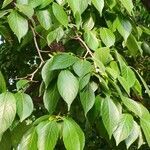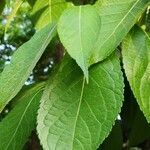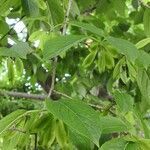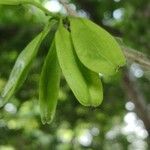A deciduous tree. It grows 20 m high. It is a broadly spreading tree. The bark is pale grey and deeply cracked. The leaves are oval and 20 cm long by 9 cm wide. They are leathery and taper to the tip. There are teeth around the edge. The leaves are glossy and dark green and droop on thin shoots. The side veins are prominent. The male and female flowers are on separate plants. The flowers are very small and without petals. They grow on old shoots. The fruit are green and winged. They occur in clusters and are 4 cm long. Each key contains a seed. The leaves have a rubbery latex.
Trees to 20 m; bark gray-brown, ridged and furrowed; branchlets brown, hairy when young, becoming glabrate, pith septate. Leaves: petioles 1–2.5 cm; blades elliptical to ovate, 5–20 × 2.5–8 cm, base usually truncate to broadly cordate or cuneate, sometimes oblique, apex acuminate, surfaces hairy when young, soon glabrate; latex strands visible in carefully torn leaf. Staminate flowers: anthers 10–12 mm. Pistillate flowers: pistil 10–12 mm. Samaras brown, 25–32 mm, apex emarginate. Seeds 12–15 × 3 mm. 2n = 34.





